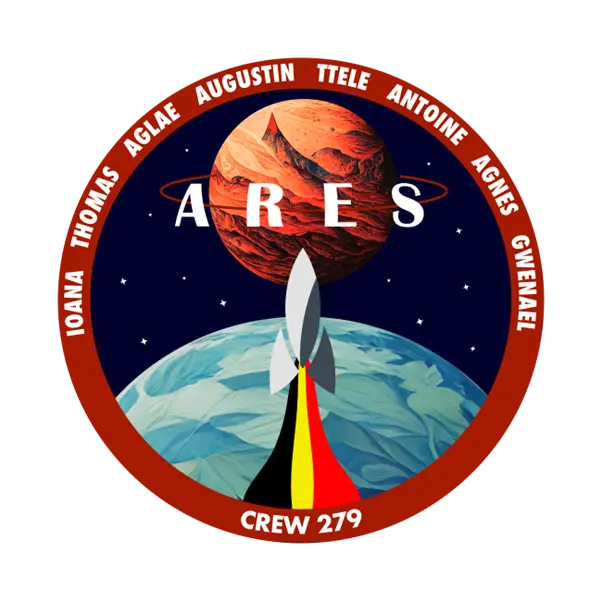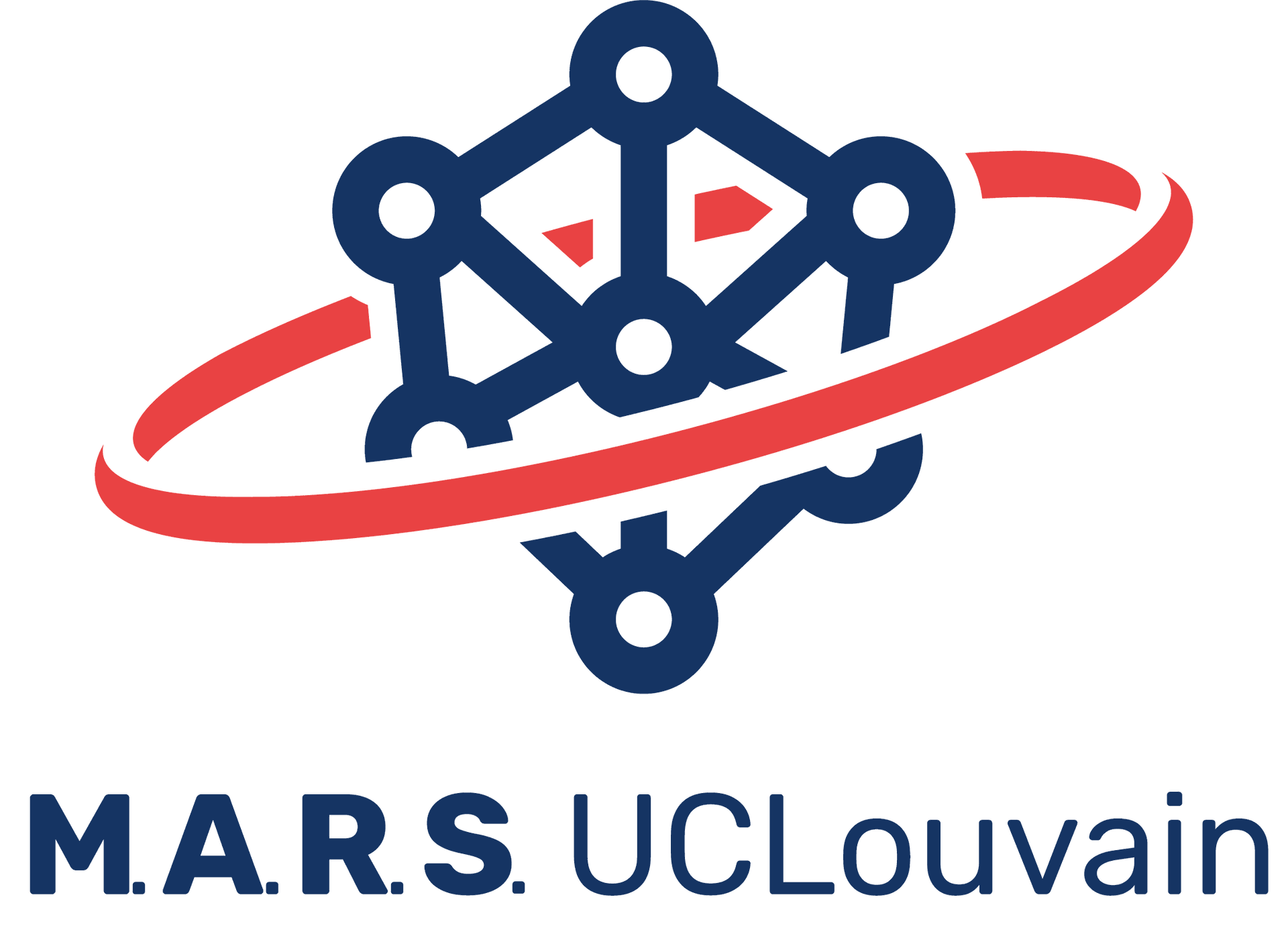Ares - Crew 279
Our team, M.A.R.S. UCLouvain 2022-23, is the 279th crew to take part in the MDRS project since its beginnings in 2001. It is also the 13th team from UCLouvain. Our crew is composed of PhD and Master students.
The rotation that was assigned to us starts the 30th of March 2023 and ends two weeks later, the 14th of April.
The Team

Ioana Dimitrova,
Crew Engineer
Biomedical Engineering

Antoine de Barquin,
Crew Commander
Bio-ingenieur Nutrition & Health

Thomas Stinglhamber,
Crew Scientist
Medical Physics

Aglaé Sacré,
Crew Journalist
Communication

Gwenaël le Bussy,
Crew Astronomer
Mechanical Engineering

Augustin Tribolet,
Greenhab Officer
Particle Physics

Agnès Dekeyser,
Executive Officer
Biomedical Sciences

Ttele Hiriart,
Health and Safety Officer
Medicine

The experiments
Study on the influence of the specific nutrition of astronauts on the microbiota - Antoine's experiment
Thanks to an experiment previously carried out on astronauts, we know that containment has an impact on our microbial flora that we call our “second brain”. But containment will not be the only parameter to have an impact on our micro-organisms. The specific food of the astronauts is obviously a major element and my experiment will consist in studying the changes on our microbiota caused by this specific food
Study of the biocompatibility of the Martian environment for Terrestrial organisms - Agnès's experiment
Terraforming Mars? Why? Well, because life as we know it cannot survive to Mars’ extreme conditions. But that may not be entirely true. Indeed, some organisms on Earth have the ability to survive conditions that are lethal to most other organisms, they are called extremophiles. But could they withstand Mars’ extreme conditions ? This is the question this study aims to answer.
Extremophiles will be exposed to the environmental conditions found at the MDRS site simulating the pressure, temperature and radiation found on Mars. At different time points, their viability will be assessed and compared to that of their unexposed analogues.
Understanding how these organisms manage to survive such extreme conditions could lead to interesting research, such as studying how we could use their ability to facilitate habitation on Mars for humans as well as for plants or animals.
Study on Mars radiation - Thomas' experiment
The radiation is invisible and odorless. The martionauts on mars will have to face this invisible enemy much more than we on earth. So how do you protectthem? By deploying a whole series of dosimeters. Each person will have 1, 1 will be put outside, 1 inside, 1 underground and 1 in Belgium to compare the different doses to a reference. All this will allow me to calculate the effectiveness of the shielding of the station as well as of the ground and above all to establish a threshold for the martionautes. In addition, thanks to a NaI scintillator, I will map the surroundings of the base to make a 3D map. I will collect samples from the places with the most radiation to do analyzes in Belgium to find out what the isotopes are and in what proportion.
Exploring Drone Utility for Radiation Protection on Martian Ground and Underground - Augustin's experiment
One of the greatest challenges for manned missions to Mars is the high radiation environment that exists in space. Unlike Earth, Mars has a very weak magnetic field and an extremely thin atmosphere, which does not offer sufficient protection against incoming radiation. A promising strategy is to use the Martian ground and underground as a natural shield against such level of radiation. To this end, this project explores the feasibility of using a drone as a valuable tool for locating and analysing potential entrances to the underground. During the maximum activity of the sun, there are extreme solar events that can also contribute to radiation on Mars. In particular, coronal mass ejections unpredictably eject large amounts of energetic particles into space. Under certain conditions, the particles can reach the surface of Mars and could surprise astronauts during an extravehicular activity. The idea here is to use the drone to see how to make the best use of the terrain to be protected from these unpredictable events.
Development of the emergency procedure - Gwenaël's experiment
The Martian
environmentis not suitable forthe survival of human beings. So, what would
happen if the protective layer around the astronauts were to be damaged? Then
our astronauts would be exposed to the greatest of dangers. They must react
fast to guarantee the mission survival. Therefore, a simple and explicit
procedure must be defined if something were to happen inside the station. It
will be based on multiple factors: participants personality, compilation on the
safety standards, inventory on goods and equipment on site, implementation of
fake scenarios, first aid procedures and so on. All the astronauts will
participate actively in the development of this procedure to make it easy and
durable.
Space Oddity: reducing stress with music ? - Ioana's experiment
Confinement and isolation is difficult for every crew that leaves the Earth. It leads to stress that can impact the body in a negative way, psychologically but also physically by increasing cortisol and blood pressure levels. One solution to this problem could be listening to music; it’s pleasant and not a complicated strategy to to implement! I will be thus be studying how listening to recorded and live music can help reduce this stress and how it can positively impact the astronauts stay in space !
Study of psychological and behavioral adaptation to isolated and confined environments - Ttele's experiment
I have always been interested in people’s relationships and interactions. Creating a strong and unit crew is not easy when you start with a team of foreigners. By completing questions files, making several exercises, mental games and using actual psychological tools I would like to analyze the personalities, emotions, desires, expectations, and fears of my teammates. Also, studying people’s behavior can lead to some answers in the interpretation of their reactions in front of different situations. This would make easier the creation of our own tools to get well together and be able to resolve internal problems. I think it is essential to respect the wellbeing of everyone and to understand the different needs of one another. All that in the aim of creating a Working together team who can count on each other.
Study on the isolation of social networks - Aglaé's experiment
We are constantly connected to social networks and information. So connected that sometimes our relationships with others are impacted. So what would be the impact on us and our relationships with others by being disconnected for 2 weeks as part of a life simulation on mars. For this, I will study the individual use of each person before, study the relationships between us during and then analyze the after and our relationship to social networks and information. The second part of my experiment will be to test our reflexes. We will be submitted to a stressful environment, to fatigue,… will these factors influence our reaction time. This study will be conducted on the basis of a software with exercises to test our reflexes.
